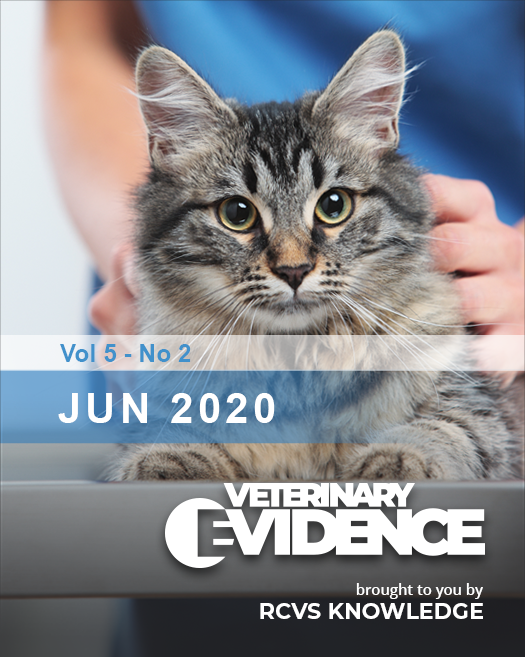DOI
https://doi.org/10.18849/ve.v5i2.278Abstract
PICO question
In dogs in shelters does pheromonotherapy reduce stress compared to untreated dogs?
Clinical bottom line
Category of research question
Treatment
The number and type of study designs reviewed
Two studies were evaluated, one was a prospective blinded randomised placebo-controlled study (Tod et al., 2005) and the other was a prospective unblinded repeated measures study
Strength of evidence
The papers evaluated provide a weak-to-moderate strength of evidence, due to the limited sample size and short duration of the intervention
Outcomes reported
In both studies pheromonotherapy resulted in a statistically significant reduction in mean bark amplitude but not in duration or peak bark amplitude. Neither study found a significant change in expression of fear-related behaviours in response to a neutral stranger or a stressor
Conclusion
Based on the studies assessed in this Knowledge Summary it is not possible to determine if pheromonotherapy reduces stress in dogs in shelter environments. It cannot be determined whether the small absolute reduction in bark amplitude present in both studies is clinically or biologically significant. Additionally, barking is a non-specific behaviour (Protopopova, 2016; Pongráczet al., 2010; Taylor & Mills, 2007; and Yin, 2002), so these results cannot be interpreted as a reduction in stress without further study.
It is beyond the scope of this Knowledge Summary to comment on any perceived or apparent difference in the effectiveness of pheromonotherapy in the shelter environment compared to the home environment
How to apply this evidence in practice
The application of evidence into practice should take into account multiple factors, not limited to: individual clinical expertise, patient’s circumstances and owners’ values, country, location or clinic where you work, the individual case in front of you, the availability of therapies and resources.
Knowledge Summaries are a resource to help reinforce or inform decision-making. They do not override the responsibility or judgement of the practitioner to do what is best for the animal in their care.
![]()
![]()
References
Barlow, N. & Goodwin, D. (2009). ‘Efficacy of Dog Appeasing Pheromone (D.A.P.®) in reducing stress related responses in rescue shelter dogs’, Proceedings of the Companion Animal Behaviour Therapy Study Group.
Brown, W., Davidson, J. & Zuefle, M. (2013). ‘Effects of Phenotypic Characteristics on the Length of Stay of Dogs at Two No Kill Animal Shelters’, Journal of Applied Animal Welfare Science, 16(1), 12–18. DOI: https://doi.org/10.1080/10888705.2013.740967
BSAVA (2017). ‘BSAVA Small Animal Formulary, Part A: Canine and Feline: Dog Appeasing Pheromone’ 9th Ed. Wiley.
Ceva Santé Animale (2020). ADAPTIL Product FAQs: learn about ADAPTIL Home Diffuser & learn about ADAPTIL Transport.
Ceva Santé Animale (2015). EU Comprehensive References: Feliway & Adaptil.
Frank, D., Beauchamp, G. & Palestrini, C. (2010). ‘Systematic review of the use of pheromones for treatment of undesirable behavior in cats and dogs’, Journal of the American Veterinary Medicine Association, 236(12), 1308–1316. DOI: https://doi.org/10.2460/javma.236.12.1308
Hermiston, C., Montrose, V. & Taylor, S. (2018). ‘The Effects of dog-appeasing pheromone stray upon canine vocalizations and stress-related behaviours in a rescue shelter’, Journal of Veterinary Behavior, 26, 11–16. DOI: http://doi.org/10.1016/j.jveb.2018.03.013
Kiddie, J. & Collins, L. (2014). ‘Development and validation of a quality of life assessment tool for use in kennelled dogs (Canis familiaris)’, Applied Animal Behaviour Science, 158, 57–68. DOI: https://doi.org/10.1016/j.applanim.2014.05.008
Pongrácz, P., Molnár, C. & Miklósi, A. (2010). ‘Barking in family dogs: an ethological approach’, The Veterinary Journal, 183(2), 141–147. DOI: https://doi.org/10.1016/j.tvjl.2008.12.010
Protopopova, A. (2016). ‘Effects of sheltering on physiology, immune function, behaviour, and the welfare of dogs’, Physiology & Behaviour, 159, 96–103. DOI: https://doi.org/10.1016/j.physbeh.2016.03.020
Sales, G., Hubrecht, R., Peyvandi, A., Milligan, S. & Shield, B. (1997). ‘Noise in dog kennelling: is barking a welfare problem for dogs?’, Applies Animal Behaviour Science, 52(3–4), 321–329. DOI: https://doi.org/10.1016/S0168-1591(96)01132-X
Taylor, K. & Mills, D. (2007). ‘The effect of kennel environment on canine welfare: a critical review of experimental studies’, Animal Welfare, 16(4), 435–447. DOI: https://www.ingentaconnect.com/contentone/ufaw/aw/2007/00000016/00000004/art00003
Tod, E., Brander, D. & Waran, W. (2005). ‘Efficacy of dog appeasing pheromone in reducing stress and fear related behaviour in shelter dogs’, Applied Animal Behaviour Science, 93 (3-4), 295–308. DOI: https://doi.org/10.1016/j.applanim.2005.01.007
UC Davis Koret Shelter Medicine Programme (2017). Adoption Driven Capacity.
Yin, S. (2002). ‘A new perspective on barking in dogs (Canis familiaris)’, Journal of Comparative Psychology, 117(2), 189–193. DOI: http://dx.doi.org/10.1037/0735-7036.116.2.189
License
Copyright (c) 2020 Tighearnan Fiachra Mooney

This work is licensed under a Creative Commons Attribution 4.0 International License.
Veterinary Evidence uses the Creative Commons copyright Creative Commons Attribution 4.0 International License. That means users are free to copy and redistribute the material in any medium or format. Remix, transform, and build upon the material for any purpose, even commercially - with the appropriate citation.
Similar Articles
- Chun Fung Wong, Merran Govendir, Can dog appeasing pheromone ameliorate stress behaviours associated with anxiety in mature domestic dogs? , Veterinary Evidence: Vol. 6 No. 4 (2021): The fourth issue of 2021
You may also start an advanced similarity search for this article.
